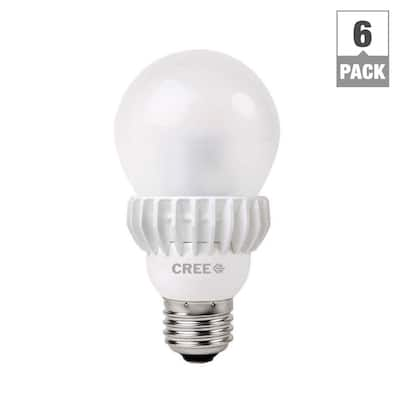You've heard about LED light bulbs. But you're still using incandescent bulbs? It's time to make a change!
When most of us think about "going green," we imagine ripping open our walls to accommodate new insulation, spending thousands of dollars on solar panels, or perhaps hiring an electrician to install smart thermostats.
One 60W Cree LED bulb in each of the bedside lamps and three 75W Cree LED bulbs in the overhead fixture
These may all be worthwhile investments. But they’re projects that take planning and motivation. And the LEED for Homes program (in which Sunset Green Home is participating) rewards projects for both large and small sustainability measures. So in this month's Practical Sustainability column, I say start with something easy. There’s one thing that you can do today - right now, even! - to reduce your impact on the environment without breaking the bank.
What I'm talking about is changing your light bulbs. And I don’t mean CFLs. Frankly, I've never been a fan of them. And they still come fraught with disposal problems (and woe to you if you break one and have to deal with a mercury spill). I'm talking about LED light bulbs. They've come way down in price, emit light that is comparable to your existing incandescent bulbs, and - if you happen to be a card-carrying member of the AARP - they'll last long enough that you may never have to change your light bulbs again!
Between February 2012 and March 2013, the US Department of Energy conducted a three-part study that evaluated the life-cycle impact of LED replacement bulbs versus CFLs and traditional incandescent lamps (you can read a summary of the study here). On almost every dimension evaluated, LED light bulbs come out ahead.
On an apples-to-apples basis, life-cycle energy consumption of LED bulbs (including the energy used in manufacturing, packaging and transporting the bulbs, in addition to the energy consumed when they are in use) is roughly equivalent to mercury-containing CFLs, and only one quarter that of traditional incandescent bulbs. 2015 LED performance targets, if met, would decrease their life cycle energy use again by half, making LED bulbs the clear winners in terms of energy consumption.
We are choosing LED light bulbs for the Sunset Green Home project for several reasons. In addition to their energy efficiency, LED light bulbs produce light without the heat of incandescent bulbs. Less heat means a lower cooling load, and that will enable us to reduce the size of our HVAC equipment. So, we'll save money over time with the lower energy consumption of LED light bulbs and we'll save money up front by purchasing less cooling capacity in our air conditioning system.
My parents visited me recently and were impressed with the look and light quality of the LED bulbs in my apartment. When my mother, who is in her 70s, described placing a step stool on top of their mattress and then trying to keep her balance while changing the bulbs over her bed, I thought "never again!" We walked to my local Home Depot and bought her some of the Cree LED light bulbs so that she can replace the bulbs over her bed and in her kitchen recessed light fixtures – and I can rest easier knowing that I won’t get a phone call about how she broke a bone falling off a ladder while trying to change a light bulb!
If you’re looking for justification for changing to LED light bulbs, here you go:
1. They’re more energy efficient. Over their lives, they’ll save you money
2. They’re friendlier to the environment than CFLs and even traditional incandescent bulbs
3. LED light bulbs should last for years – so putting them in hard-to-reach places is a “no brainer” – you may never have to change the bulbs again…and this is great news if you are more “senior” and don’t want to risk falling from a ladder!
Having had such success replacing my incandescent bulbs, I have decided to replace the light bulbs in 22 recessed low voltage halogen fixtures too. These bulbs are more expensive, but I've had trouble with the halogen bulbs' light output and dependability (not to mention that they're energy hogs!), so I'm eager to try something different, and LEDs appear to be the best option. At around $30 per bulb, I'm going to replace them in batches, starting with my recessed kitchen fixtures. I'll report back when I have a final result!
So what are you waiting for? This is Practical Sustainability...It’s time to change your light bulbs. And LED light bulbs are the answer!

